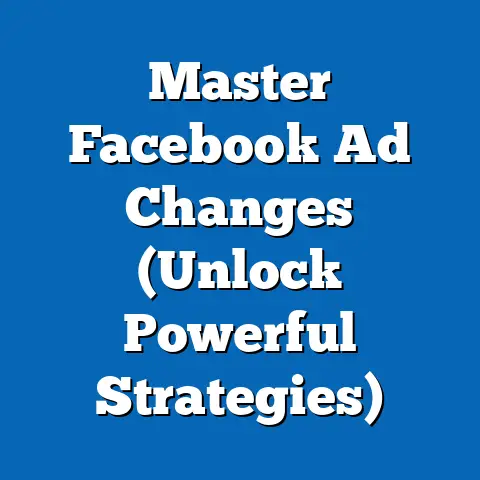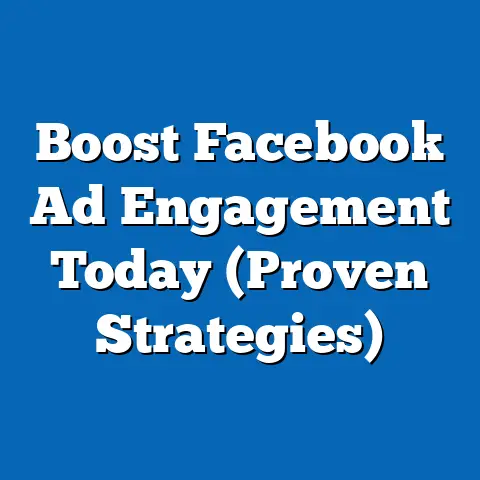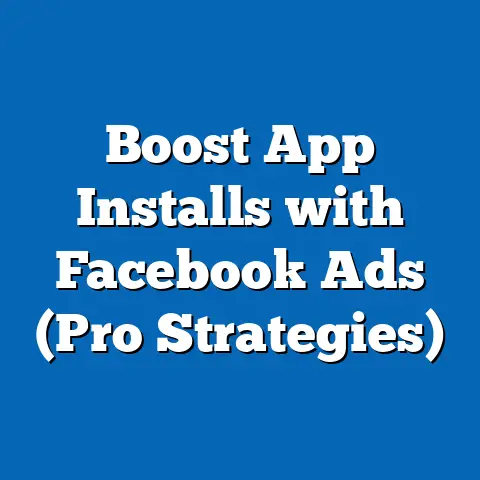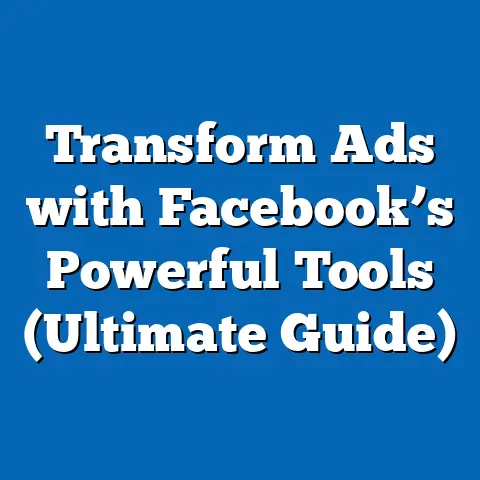Boost Real Estate Sales with Facebook Ads (Expert Tips)
The concept of “smart living” has completely reshaped how we interact with our homes and, more broadly, the real estate market. Technology touches every aspect of our lives now, and buying or selling a property is no exception. Gone are the days of solely relying on newspaper ads and open houses. Today, digital marketing, particularly through social media platforms like Facebook, is the key to connecting buyers and sellers.
I’ve seen firsthand how a well-crafted Facebook ad campaign can transform a real estate agent’s business. In this article, I’m going to share some expert tips that I’ve learned over the years to help you leverage the power of Facebook Ads and boost your real estate sales. We’ll dive into everything from crafting compelling ad campaigns to understanding your budget and analyzing ad performance. So, let’s get started and unlock the potential of Facebook Ads for your real estate business!
Understanding the Power of Facebook Ads in Real Estate
Facebook isn’t just a place for sharing cat videos and family photos; it’s a marketing powerhouse, especially for real estate professionals. With billions of active users worldwide, Facebook offers unparalleled reach and targeting capabilities. Think about it: potential homebuyers are already spending a significant amount of time on the platform, browsing, connecting, and discovering new things. Why not put your listings right in front of their eyes?
Here’s why Facebook is so significant for real estate marketing:
- Massive User Base: Facebook boasts billions of active monthly users, providing a vast pool of potential clients.
- Detailed Demographics: Facebook’s data collection allows precise targeting based on age, location, interests, income, and even life events like getting married or having a child – all key indicators of potential homebuyers.
- Visual Appeal: The platform thrives on visual content, making it perfect for showcasing stunning property photos and engaging video tours.
- Engagement Opportunities: Facebook allows for direct interaction with potential clients through comments, messages, and live Q&A sessions.
According to recent statistics, real estate ads on social media platforms, including Facebook, have a significantly higher click-through rate (CTR) compared to traditional methods. For example, a study by the National Association of Realtors found that agents who actively use social media generate 25% more leads than those who don’t.
Facebook offers a variety of ad formats, each with unique advantages for real estate listings:
- Single Image Ads: These are simple yet effective for showcasing a property’s best feature. A captivating image can draw immediate attention.
- Video Ads: Perfect for virtual tours, neighborhood overviews, or agent introductions. Videos can create an emotional connection and provide a more immersive experience.
- Carousel Ads: These allow you to showcase multiple properties or different aspects of a single property in a single ad. This format encourages engagement and allows users to explore more options.
- Lead Ads: Designed to collect contact information from potential clients directly within Facebook. These are ideal for generating leads for open houses or property inquiries.
- Instant Experience Ads: Offer a full-screen, immersive experience that loads quickly on mobile devices. These can be used to create interactive property tours or showcase a real estate agency’s brand story.
Takeaway: Facebook Ads provide a powerful and versatile platform for reaching potential homebuyers. Understanding the platform’s capabilities and choosing the right ad formats is crucial for success.
Crafting a Compelling Ad Campaign
Creating a successful Facebook ad campaign for real estate involves several key steps. It’s not just about throwing up an ad and hoping for the best; it’s about strategic planning and execution.
Defining Your Objectives
Before you even start designing your ad, you need to define your objectives. What do you want to achieve with your campaign? Are you looking to:
- Generate Leads: Collect contact information from potential buyers or sellers.
- Increase Brand Awareness: Build recognition for your real estate agency.
- Drive Traffic to Your Website: Get more visitors to your property listings.
- Promote a Specific Property: Highlight a particular listing to attract potential buyers.
- Announce an Open House: Get the word out about an upcoming open house event.
Your objective will influence every aspect of your ad campaign, from the ad format you choose to the targeting options you use. For example, if your goal is lead generation, you’ll want to use Lead Ads. If you want to drive traffic to your website, you’ll use an ad with a clear call-to-action (CTA) button linking to your listings.
Targeting the Right Audience
Facebook’s targeting options are incredibly powerful. You can target your ads based on a wide range of factors, including:
- Location: Target people living in a specific city, neighborhood, or even within a certain radius of a property.
- Demographics: Target based on age, gender, education, income, and marital status.
- Interests: Target people interested in real estate, home buying, home improvement, or specific neighborhoods.
- Behaviors: Target people who have recently moved, are likely to move, or have shown interest in buying a home.
- Custom Audiences: Upload your existing customer list to target people who have already interacted with your business.
- Lookalike Audiences: Create audiences that are similar to your existing customers, expanding your reach to new potential clients.
For example, if you’re selling a luxury condo in a downtown area, you might target affluent professionals aged 35-55 who are interested in urban living and have a history of investing in real estate.
I once worked with a real estate agent who was struggling to sell a property in a specific neighborhood. We used Facebook’s detailed targeting to reach people who had recently searched for homes in that area, as well as those who had shown interest in local schools and community events. The result was a significant increase in inquiries and ultimately, a successful sale.
Creating Eye-Catching Visuals
In the world of Facebook Ads, visuals are king. People scroll through their feeds quickly, so you need to grab their attention instantly. Here are some tips for selecting high-quality images and videos:
- Use Professional Photography: Invest in professional photos that showcase your properties in the best possible light.
- Highlight Key Features: Focus on the most appealing aspects of the property, such as a stunning view, a modern kitchen, or a spacious backyard.
- Show the Lifestyle: Create visuals that evoke a sense of lifestyle and aspiration. Show people enjoying the property, whether it’s cooking in the kitchen, relaxing in the living room, or playing in the backyard.
- Use Video Tours: Create virtual tours that allow potential buyers to explore the property from the comfort of their own homes.
- Keep it High-Resolution: Ensure your images and videos are high-resolution and optimized for Facebook’s ad specifications.
Writing Persuasive Ad Copy
Your ad copy is just as important as your visuals. It’s your chance to tell a story, highlight the benefits of the property, and persuade potential buyers to take action. Here are some guidelines:
- Write Compelling Headlines: Your headline is the first thing people will see, so make it count. Use strong, attention-grabbing language that highlights the key benefits of the property.
- Focus on the Benefits: Don’t just list the features of the property; focus on the benefits it offers to potential buyers. For example, instead of saying “3 bedrooms, 2 bathrooms,” say “Enjoy spacious living with 3 bedrooms and 2 bathrooms, perfect for a growing family.”
- Use a Clear Call-to-Action: Tell people exactly what you want them to do. Use phrases like “Learn More,” “Schedule a Showing,” or “Download Our Free Guide.”
- Keep it Concise: People have short attention spans, so keep your ad copy concise and to the point.
- Use Emotionally Charged Language: Connect with potential buyers on an emotional level by using language that evokes feelings of warmth, comfort, and security.
Takeaway: A compelling ad campaign starts with clear objectives, targeted audience selection, eye-catching visuals, and persuasive ad copy.
Budgeting and Ad Spend Strategies
Setting a budget for your Facebook Ads can feel like a guessing game, but it doesn’t have to be. Understanding the underlying principles and implementing smart strategies can help you maximize your return on investment.
Understanding CPC and CPM
Before you set your budget, it’s essential to understand two key metrics:
- Cost-Per-Click (CPC): The amount you pay each time someone clicks on your ad.
- Cost-Per-Impression (CPM): The amount you pay for every 1,000 times your ad is shown.
CPC is typically used when your goal is to drive traffic to your website, while CPM is often used for brand awareness campaigns. The cost of CPC and CPM can vary depending on your target audience, the competition in your market, and the quality of your ad.
Allocating Budgets for Different Campaigns
It’s a good idea to allocate your budget across different campaigns based on your objectives. For example, you might allocate a larger portion of your budget to lead generation campaigns if your primary goal is to collect contact information.
When starting out, I recommend testing different ad campaigns with smaller budgets to see what works best. Once you’ve identified the most effective campaigns, you can increase your budget accordingly.
Testing Ad Performance and Optimizing Spending
A/B testing is crucial for optimizing your ad spend. This involves creating multiple versions of your ad with different headlines, visuals, or CTAs and then testing them against each other to see which performs best.
Facebook Ads Manager provides detailed analytics that allow you to track the performance of your ads and identify areas for improvement. Pay attention to metrics like CTR, conversion rate, and cost-per-lead.
Based on your results, you can adjust your targeting, refine your ad copy, or change your visuals to improve performance. It’s an iterative process of testing, analyzing, and optimizing.
Takeaway: Setting a budget for Facebook Ads requires understanding CPC and CPM, allocating budgets strategically, and constantly testing and optimizing your ad performance.
Analyzing Ad Performance
Tracking and analyzing your Facebook ad performance is essential for understanding what’s working and what’s not. Without data, you’re just flying blind.
Tools for Tracking Ad Performance
Facebook Ads Manager is your primary tool for tracking and analyzing your ad performance. It provides a wealth of data on your campaigns, ads, and target audiences.
Within Ads Manager, you can track key metrics like:
- Impressions: The number of times your ad has been shown.
- Reach: The number of unique people who have seen your ad.
- Clicks: The number of times people have clicked on your ad.
- Click-Through Rate (CTR): The percentage of people who saw your ad and clicked on it.
- Cost-Per-Click (CPC): The amount you paid for each click.
- Conversions: The number of people who took a desired action, such as filling out a lead form or visiting your website.
- Cost-Per-Conversion: The amount you paid for each conversion.
Key Performance Indicators (KPIs)
Real estate agents should monitor several key performance indicators (KPIs) to gauge the success of their Facebook ad campaigns:
- Click-Through Rate (CTR): A high CTR indicates that your ad is resonating with your target audience.
- Engagement Rate: Measures how people are interacting with your ad, including likes, comments, and shares.
- Conversion Rate: The percentage of people who take a desired action after clicking on your ad.
- Cost-Per-Lead: The amount you pay for each lead generated through your Facebook ads.
- Return on Ad Spend (ROAS): The amount of revenue you generate for every dollar you spend on Facebook ads.
Interpreting Data and Making Adjustments
Analyzing your data is crucial for making informed adjustments to your ad campaigns. For example, if you notice that your CTR is low, it might indicate that your ad copy or visuals aren’t compelling enough. If your cost-per-lead is high, you might need to refine your targeting or improve your lead form.
I’ve seen many real estate agents make the mistake of setting up a campaign and then just letting it run without monitoring the results. Regularly reviewing your data and making adjustments is essential for maximizing your ROI.
Takeaway: Analyzing ad performance through Facebook Ads Manager, monitoring key KPIs, and interpreting data are crucial for optimizing your Facebook ad campaigns.
Real-Life Success Stories and Case Studies
To illustrate the power of Facebook Ads in real estate, let’s look at some real-life success stories and case studies.
Case Study 1: Local Real Estate Agency Generates Leads
A local real estate agency in a competitive market was struggling to generate leads through traditional methods. They decided to invest in Facebook Ads, focusing on lead generation campaigns.
They created a series of Lead Ads that offered a free guide to buying a home in the area. The ads targeted potential homebuyers based on their location, income, and interests.
The results were impressive. In just three months, the agency generated over 200 qualified leads at a cost of just $10 per lead. They converted a significant percentage of those leads into clients, resulting in a substantial increase in revenue.
Case Study 2: Agent Promotes a Luxury Property
A real estate agent was tasked with selling a luxury property in a high-end neighborhood. They decided to use Facebook Ads to showcase the property to potential buyers.
They created a video ad that featured a virtual tour of the property, highlighting its unique features and amenities. The ad targeted affluent individuals in the area who were interested in luxury real estate.
The ad generated a significant amount of buzz, resulting in numerous inquiries and showings. The property sold within two months at the asking price.
Lessons Learned
These case studies highlight several key lessons:
- Targeting is Key: Facebook’s detailed targeting options allow you to reach the right audience with the right message.
- Visuals Matter: High-quality images and videos are essential for capturing attention and showcasing properties effectively.
- Lead Generation Campaigns Can Be Highly Effective: Lead Ads can be a powerful tool for generating qualified leads at a reasonable cost.
- Facebook Ads Can Drive Sales: When used strategically, Facebook Ads can significantly boost real estate sales.
Takeaway: Real-life success stories demonstrate the effectiveness of Facebook Ads in real estate, highlighting the importance of targeting, visuals, and strategic campaign design.
Conclusion
In today’s smart living landscape, where technology permeates every aspect of our lives, Facebook Ads have become an indispensable tool for real estate professionals. The platform’s massive reach, detailed targeting capabilities, and diverse ad formats make it a powerful engine for generating leads, building brand awareness, and ultimately, driving sales.
I hope this article has provided you with valuable insights and actionable tips for leveraging Facebook Ads to enhance your real estate business. Remember, success with Facebook Ads requires a strategic approach, continuous testing, and a willingness to adapt to the ever-changing digital landscape.
So, embrace the digital transformation in real estate marketing and start implementing the expert tips discussed in this article. Explore the power of Facebook Ads as a way to connect with clients, showcase your properties, and take your real estate business to the next level.
Are you ready to connect with clients and drive sales? Take the first step and explore Facebook Ads as a powerful tool for your real estate business today!






